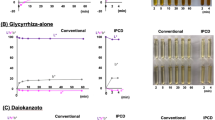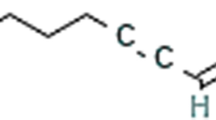Abstract
One topical pour-on drug product formed a slightly yellow color and continued to increase the intensity over the shelf life of the product. This caused out-of-specification (OOS) results for the color of the drug product. Based on the experimental results obtained using high-performance liquid chromatography, high-resolution mass spectrometry, and a color measurement spectrophotometer, the root cause of color formation in the OOS sample was identified and confirmed to be 3,3′,5,5′-tetra-t-butyl-4,4’-stilbenequinone (2BHT-QM), an oxidative degradation product of t-butylated hydroxytoluene (BHT) which is used in this drug product as an antioxidant. The content of 2BHT-QM in the OOS sample was estimated to be about 0.9–1 ppm by two independent analytical methods. The results from our investigation clearly indicated that BHT can cause color change in liquid or semi-liquid formulation (drug product) and we report this for the first time. The investigation approach and rationale of described in this paper should be helpful for similar investigations when BHT is used in liquid or semi-liquid formulations.








Similar content being viewed by others
References
Guidance for Industry, Q1A(R2) Stability Testing of New Drug Substances and Products (2003) U.S. Department of Health and Human Services, Food and Drug Administration, Center for Drug Evaluation and Research (CDER), Center for Biologics Evaluation and Research (CBER), Version 2, Nov 2003
ICH Q1A(R2) (2003) Stability testing of new drug substances and products, ICH Harmonised Tripartite Guideline
ICH Q6A (1999) Specification: test procedures and acceptance criteria for new drug substances and Bew drug products: chemical substances, ICH Harmonised Tripartite Guideline
Guidance for Industry, Investigating Out-of-Specification (OOS) Test Results for Pharmaceutical Production (2006) U.S. Department of Health and Human Services, Food and Drug Administration, Center for Drug Evaluation and Research (CDER)
Yehye WA, Rahman NA, Ariffin A, Hamid SBA, Alhadi AA, Kadir FA, Yaeghoobi M (2015) Understanding the chemistry behind the antioxidant activities of butylated hydroxytoluene (BHT): a review. Eur J Med Chem 101:295–312. https://doi.org/10.1016/j.ejmech.2015.06.026
Reische DW, Lillard DA, Eitenmiller RR (1998) Antioxants, Food Sci Technol. New York, pp. 423–448
Fujisawa S, Kadoma Y, Yokoe I (2004) Radical-scavenging activity of butylated hydroxytoluene (BHT) and its metabolites. Chem Phys Lipids 130:189–195. https://doi.org/10.1016/j.chemphyslip.2004.03.005
Waterman KC, Adami RC, Alsante KM, Hong J, Landis MS, Lombardo F, Roberts CJ (2002) Stabilization of pharmaceuticals to oxidative degradation. Pharm Dev and Technol 7:1–32. https://doi.org/10.1081/pdt-120002237
Burton GW, Ingold KU (1981) Autoxidation of biological molecules. 1. antioxidant activity of vitamin E and related chain-breaking phenolic antioxidants in vitro. J Am Chem Soc 103:6472–6477. https://doi.org/10.1021/ja00411a035
Babich H (1982) Butylated hydroxytoluene (BHT): a review. Environ Res 29:1–29. https://doi.org/10.1016/0013-9351(82)90002-0
Pryor WA, Strickland T, Church DF (1988) Comparison of the efficiencies of several natural and synthetic antioxidants in aqueous SDS [sodium dodecyl sulfate] micelle solutions. J Am Chem Soc 110:2224–2229. https://doi.org/10.1021/ja00215a036
Lambert CR, Black H, Truscott G (1996) Reactivity of butylated hydroxytoluene. Free Radic Biol Med 21:395–400. https://doi.org/10.1016/0891-5849(96)00050-0
Cook CD (1953) Oxidation of hindered phenols. I. Oxidation of and oxidation inhibition by 2,6-Di-tert-butyl-4-methylphenol. J Org Chem 18:261–266. https://doi.org/10.1021/jo01131a005
Stebbins R, Sicilio F (1970) The kinetics of disproportionation of the 2,6-di-t-butyl-4-methyl phenoxy radical. Tetrahedron 26:291–297. https://doi.org/10.1016/0040-4020(70)85030-X
Thomas MJ, Foote CS (1977) Chemistry of singlet oxygen—XXVI. Photooxygenation of phenols. Photochem Photobiol 26:19–27. https://doi.org/10.1111/j.1751-1097.1978.tb07665.x
Ma B, Peng H, J. Liu J, (2006) Monitoring of BHT-Quinone and BHT-CHO in the Gas of Capsules of Asclepias physocarpa. Z Naturforsch C J Biosci 61:458–460. https://doi.org/10.1515/znc-2006-5-625
Hoang HY, Akhmadullin RM, Akhmadullina FY, Zakirov RK, Akhmadullina AG, Gazizov AS (2018) Synthesis of 3,3’,5,5′-Tetra-tert-butyl-4,4′-stilbenequinone and Its Catalytic Activity in the Liquid-Phase Oxidation of Inorganic Sulfides. Russ J of Org Chem 54:1008–1013. https://doi.org/10.1134/S1070428018070060
Wilcockson MG, Toteva MM, Stella VJ (2013) Hydrolysis of the Quinone Methide of Butylated Hydroxytoluene in Aqueous Solutions. J Pharm Sci 102:3579–3585. https://doi.org/10.1002/jps.23657
Ahn J, Grun JU, Mustapha A (2007) Effects of plant extracts on microbial growth, color change, and lipid oxidation in cooked beef. Food Microbiol 24:7–14. https://doi.org/10.1016/j.fm.2006.04.006
Shoop WL, Egerton JR, Eary CH, Haines HW, Michael BF, Mrozik H, Eskola P, Fisher MH, Slayton L, Ostlind DA, Skelly BJ, Fulton RK, Barth D, Costa S, Gregory LM, Campbell WC, Seward RL, Turner MJ (1996) Int J Parasitol 26:1237–1242. https://doi.org/10.1016/S0020-7519(96)00123-3
W.C. Campbell WC, (2012) History of avermectin and ivermectin, with notes on the history of other macrocyclic lactone antiparasitic agents. Curr Pharm Biotechnol 13:853–865. https://doi.org/10.2174/138920112800399095
Padivitage N, Tian J, Rustum A (2021) Alternative and improved stability-indicating HPLC method for the assay of eprinomectin and determination of its related compounds in bulk batches of eprinomectin drug substance. J AOAC Int. https://doi.org/10.1093/jaoacint/qsab069 (In press)
Hoffman NE, Pan SL, Rustum AM (1989) Injection of eluites in solvents stronger than the mobile phase in reversed-phase liquid chromatography. J Chromatogr A 465:189–200. https://doi.org/10.1016/S0021-9673(01)92657-3
Zhang Y, Lucy C (2014) Effect of injection matrix concentration on peak shape and separation efficiency in ion chromatography. J Chromatogr A 1371:177–183. https://doi.org/10.1016/j.chroma.2014.10.056
Wahab MF, Anderson JK, Abdelrady M, Lucy C (2014) Peak Distortion Effects in Analytical Ion Chromatography. Anal Chem 86(1):559–566. https://doi.org/10.1021/ac402624a
Snyder LR (1974) Classification of the solvent properties of common liquids. J Chromatogr A 92:223–230. https://doi.org/10.1016/S0021-9673(00)85732-5
Neitz J, G.H. Jacobs GH, (1986) Polymorphism of the long-wavelength cone in normal human colour vision. Nature 323:623–625. https://doi.org/10.1038/323623a0
Boynton RM (1990) Human Color Perception. In: Leibovic KN (ed), Science of Vision. Springer, New York, pp.211–253. https://doi.org/10.1007/978-1-4612-3406-7_8
2.2.2 Degree of Coloration of Liquids (2021) Ph. Eur. 10.4, EDQM Council of Europe, Strasbourg, France. https://pheur.edqm.eu/
Author information
Authors and Affiliations
Corresponding author
Ethics declarations
Conflict of interest
The authors declare that they have no conflict of interest.
Additional information
Publisher's Note
Springer Nature remains neutral with regard to jurisdictional claims in published maps and institutional affiliations.
Supplementary Information
Below is the link to the electronic supplementary material.
Rights and permissions
About this article
Cite this article
Zhao, D., Wang, L., Wimalasinghe, R.M. et al. Investigation to Identify the Root Cause of Out-of-Specification Results for Color of a Topical Pour-on Drug Product: A Case Study. Chromatographia 84, 905–915 (2021). https://doi.org/10.1007/s10337-021-04077-0
Received:
Revised:
Accepted:
Published:
Issue Date:
DOI: https://doi.org/10.1007/s10337-021-04077-0




